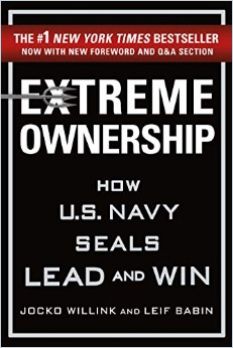Best-selling authors and former US Navy SEALs Jocko Willink and Leif Babin relate illustrative war stories and link them to crucial business issues: Own ’em, prioritize ’em, find solutions, fix ’em.

Discipline and Humility
Former US Navy SEAL officers and New York Times number one best-selling authors Jocko Willink and Leif Babin served in the Iraq War and fought in the 2006 Battle of Ramadi in SEAL Task Unit Bruiser, an outstanding special operations unit.
The two officers created and led leadership training for the US Navy special forces, the SEALs, and later opened Echelon Front, a leadership consultancy. Their combat record is exemplary, and they fought in some of the war’s toughest battles. Willink held higher rank than Babin, but their communication, commitment and willingness to examine the efficacy of their actions created a lasting bond.
Success resulted from determination and will, but also from innovation and communication within the team.Jocko Willink and Leif Babin
Leadership lessons make up barely half of their book. In each chapter, the authors detail the planning and execution of a combat mission. Surprisingly, their most illuminating leadership lessons emerge from their combat debriefings. These will intrigue readers who prefer an accountable, somewhat military-style leadership structure and can examine their own mistakes with ruthless candor.
Extreme Ownership
In the combat debriefings the authors recount (describing a then all-male division), every SEAL explains what he did and why and tries to find every mistake he made. This vulnerable willingness to hunt down and own individual – possibly life-threatening – errors offers more profound leadership lessons than the formal lessons that follow.
Taking ownership for mistakes and failures is hard. But doing so is key to learning, to developing solutions and, ultimately, to victory. Jocko Willink and Leif Babin
Few leaders or followers, for that matter, ever admit they’re wrong. Doing so is a mark of “extreme ownership”: Each man takes responsibility for his actions and their consequences and doesn’t flinch from being told how to correct his mistakes. This seems like a leadership model that might flourish in a tiny, self-selected elite unit, but would be difficult to apply in a hyper-competitive corporate environment.
Willink learned an enduring lesson during an incident of blue-on-blue or friendly fire. The SEALs under his command and the soldiers who were with them made dangerous mistakes that led to a fellow SEAL being wounded. Willink’s superiors demanded that he cease all operations until he had given them a thorough debriefing.
At various points in his briefing, Willink asked the different SEALs in the room: “Whose fault was this?” As each man tried to take blame, Willink told him that he was wrong. At the end of the briefing, Willink told the room: “There is only one person to blame for this: Me.” He acknowledged his responsibility because whatever happens under your command is always your fault. If subordinates fail, leaders must provide better training and instruction. And leaders must prioritize loyalty to those they lead. This ethos, however outstanding, also seems unlikely to manifest in a corporate culture.
When dealing with egos, your own will always be the most problematic. Signing up for extreme ownership means acquiescing to humility. To assess your performance honestly, Willink and Babin teach, you must disconnect from the demands of your ego. Then, you can inspire team loyalty and motivate your people to put their own egos aside.
Prioritize and Execute
The leader in a combat situation faces multiple problems simultaneously, most of them life-threatening. Willink and Babin warn that leaders can’t solve several problems at once. Instead, you must keep a calm head, evaluate the severity of each problem, prioritize them accordingly and execute a solution to the one you determine to be most pressing.
If I didn’t first handle the armed enemy fighters bearing down on us within the next few seconds, nothing else would matter. We would be dead. Worse, the enemy fighters would continue their attack and might kill more of our SEAL assault force. This was my highest priority. Leif Babin
Describe the highest priority effort to your team simply. Ask your subordinates for suggestions and select a solution. Deal with that problem, then shift to the next.
In business, you usually have time to weigh each problem carefully. To build the ability to prioritize and execute, prepare diligently. If you understand a task’s likely problems, you can prioritize solutions more rapidly when obstacles appear. In combat and business, be prepared and decisive.
Make your directives and policies simple. In any action, in any realm, something will go wrong. The more complex your commands are, the more likely they are to foment confusion. If you give your subordinates concise instructions on achieving a primary goal, they can focus and handle any issues that arise.
Business Lessons
Willink and Babin’s business lessons try hard. In each chapter, they attempt to draw parallels between a combat leadership lesson they lived through in wartime and a business leadership lesson they taught a client company. However, the meat is in the military accounts. Most business lessons could be, and in some cases are, distilled down to one or two key sentences.
Leadership is the most important thing on the battlefield and the principles of good leadership do not change regardless of the mission, the environment or the personalities of those involved. Leading is leading.Jocko Willink and Leif Babin
After the adrenaline rush of the combat stories, accounts of how the authors corrected business mistakes sometimes fail to engage as much and are harder to digest. In each business lesson section, a businessperson relates a problem, and the same sequence repeats: The former SEALs pose a commonsense solution. The client resists, claiming contrary previous practice. Sometime later, the client admits the SEALs were right. As these stories unfold, readers may wish for clearer links between the combat lessons and the corporate lessons, since that would make the book more readable and immediately applicable. Some readers might simply relish the combat tales and skim the business class.
Hard-Nosed Advice
Jocko Willink and Leif Babin want to give readers the leadership lessons they learned as Navy SEALs. Each chapter begins with a combat photo showing the authors as tough, competent warriors. Their prose mirrors their military background. They write in hard-nosed direct sentences, with a few favorite adjectives.
Discipline starts every day when the first alarm clock goes off. I say ‘first alarm clock’ because I have three. Jocko Willink
Even if the manuscript would benefit from a tighter edit, readers will find the authors’ wartime experiences exciting and engaging. Sometimes the flatness of their voice – which seems to stem from a just-the-facts-ma’am, warrior-dude refusal to evoke emotion – leaves you to find the drama in their combat sagas and the illuminating leadership lessons they exemplify. That noted, if you believe in close-knit teams with top-down leaders you can respect, and you aspire to be a tough-guy hero, mentor or leader, Willink and Babin speak your language.






